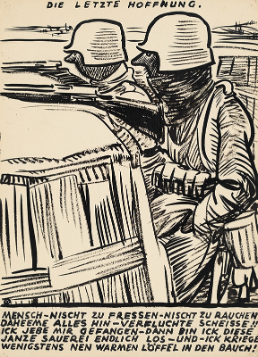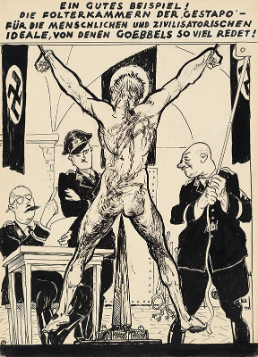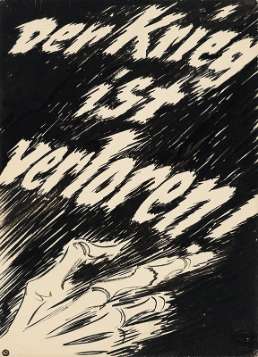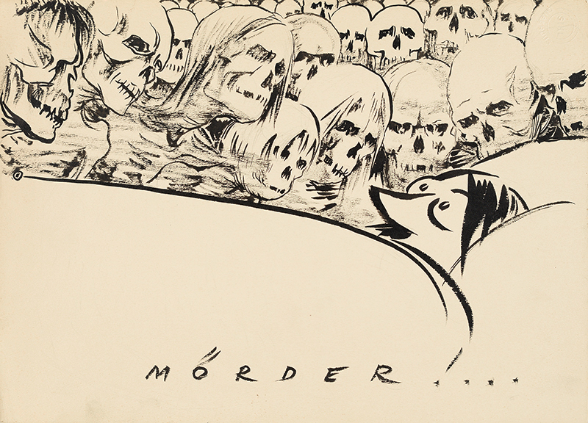Graphic artist Alexander M. Kaiser was stripped of his German citizenship and of his assets by the National Socialists in 1938. Kaiser fled Germany and was held at various labour camps in France before going to Switzerland in 1943. There, he was involved in covert operations, illustrating pamphlets for the Allies to convince the German people of the senselessness of war.
By Karl Clemens Kübler
The graphic design studio A. M. Cay in Berlin’s Schöneberg district was an in-demand agency designing posters and advertising in the late 1920s. When Alexander M. Kaiser, the man behind the famous pseudonym and busy entrepreneur, lead the conversion of one of Berlin’s biggest theatres in 1929, he was at the height of his career. Kaiser, also known as ’Cay‘ taught design and advised public institutions. He also worked for contractors in France and the United States. But everything changed in 1933 when the National Socialists came to power in Germany.
Just a few years later, Kaiser, who by then was stateless and had no assets to speak of, fled to France and then to Switzerland, moving from one labour camp to another. During that time, he drew pictures portraying the war that he had escaped, featuring skulls, corpses and bombed cities.
The Prints and Drawings Department at the National Library holds a significant part of Kaiser’s surviving works, which tell the unique story of the once established businessman and his exile to Switzerland – and of his artistic engagement against German fascism.
From Berlin to Switzerland via Paris

Soon after arriving in Switzerland, in 1943, Kaiser started producing drawings in secret, which the Office of Strategic Services (the American secret service) published in anti-Hitler pamphlets, which it sent from Bern to the German Reich to be handed out to the public. This was something of a balancing act in politically neutral Switzerland, where producing propaganda material of any kind was forbidden. The OSS in Bern masqueraded as the communications department of the US Embassy, but in reality maintained a large-scale network covering the whole of Switzerland and extending to Germany and Italy. The reluctance of frontline soldiers to keep fighting for a lost cause is exemplified in this drawing depicting a conversation between two soldiers in Berlin dialect.

Particularly after the failed assassination attempt on Hitler in 1944, agents in Bern were instructed to stir up more discontent in the German population. Kaiser’s pamphlets were designed to convince the general public and German soldiers that prolonging the war would just mean more casualties. Using text and images, the pamphlets addressed the injustice of the NS system, the crimes it committed and the personal enrichment of the ruling elite.
The problem of the transient medium

Only 66 such pamphlet illustrations that can be clearly attributed to Kaiser have survived. While their rawness may be shocking, it leaves us in no doubt of their purpose: to depict the atrocity of war in unflinching designs to highlight its senselessness. Kaiser’s principal repertoire comprises ravaged cities, people who have been tortured and murdered, and caricatures of well-known officials. He also used them to express his anger and to capture his violent fantasies towards Hitler and the power structure. But the images were primarily intended to convince the German public that capitulating to the advancing Allies was a better option than dying for Hitler.

Although the OSS had precise ideas about the messages it wanted conveyed to the Germans in the pamphlets, the illustrations still reveal Kaiser’s particular design aesthetic. They show his graphic versatility and his wealth of ideas, even in the seemingly simplistic genre of propaganda drawings. By contrasting the great Führer as a schematic stick figure with the detailed skeletons of his victims, Kaiser predicts the upcoming deliverance, whereby the dictator as a figure of fun will soon disappear and history will judge his actions.
Later life in Zurich
We can no longer trace the reach and impact of the pamphlets on the German people. After the war, Alexander M. Kaiser was able to establish himself again as a caricaturist and advertising artist under the pseudonym A. M. Cay in Zurich. He continued to produce caricatures of the great and the good for the magazines ‘Sie & Er’ and in particular ‘Nebelspalter‘ until the 1960s.
Alexander M. Kaiser alias A. M. Cay was born in Vienna on 20 September 1887. He claimed to have held Czech, and later German citizenship, before becoming stateless in the 1930s. After training as an artist in Vienna and working at theatres in London, Kaiser moved to Berlin before the First World War. There, he worked as a freelance commercial graphic artist and architect in his own studio under the pseudonym A. M. Cay. In 1929 he was commissioned to design the conversion of the Plaza Theatre in Berlin. In 1938 Kaiser went to France to flee the National Socialists and was detained in various camps after the start of the war. He then fled to Switzerland in 1943. After an ancillary activity as a drawing teacher, from 1946 Kaiser regularly produced caricatures for publications including ‘Sie und Er’ and ‘Nebelspalter’. Alexander M. Kaiser died in Zurich in 1971.
Bibliography and sources
- Klaus Kirchner; Michel Girard (Hrsg.): Flugblätter aus Frankreich 1939, 1940. Erlangen: Verlag D + C, 1981.
- Klaus Kirchner: Erotische Flugblätter in Europa im 20. Jahrhundert. Erlangen: Verlag D + C, 2010.
- Christof Mauch: Schattenkrieg gegen Hitler: das Dritte Reich im Visier der amerikanischen Geheimdienste 1941 – 1945. Stuttgart: Deutsche Verlags-Anstalt, 1999.
- Moritz Rauchhaus, Tobias Roth (Hrsg.): Eine Sammlung amerikanischer, britischer, deutscher, französischer und sowjetischer Feindflugblätter des Zweiten Weltkriegs. Berlin: Verlag Das Kulturelle Gedächtnis, 2020.
Last modification 07.04.2025
Contact
Swiss National Library
Prints and Drawings Department
Hallwylstrasse 15
3003
Bern
Switzerland
Phone
+41 58 462 89 71









